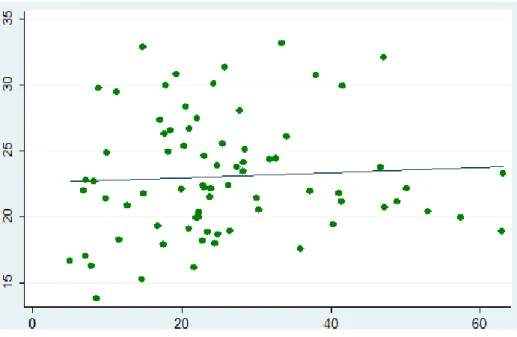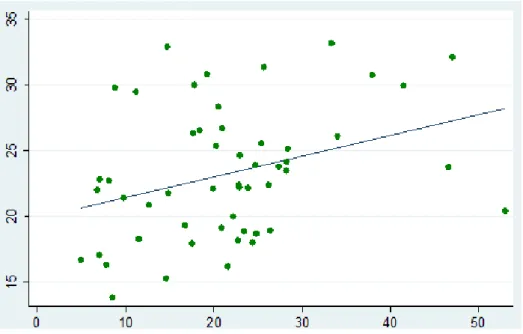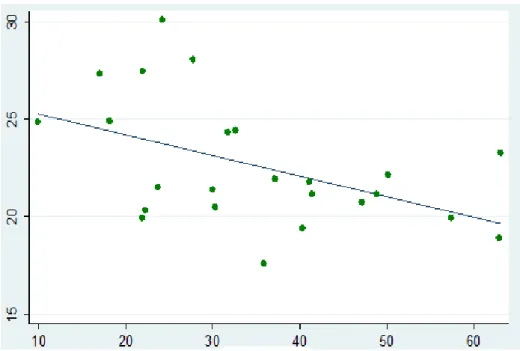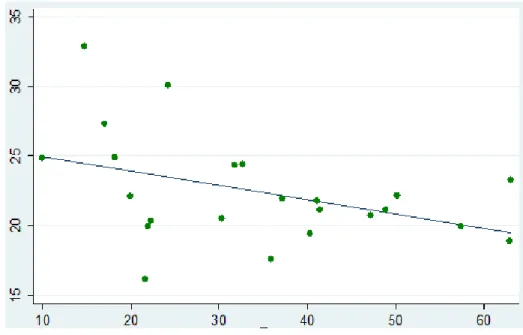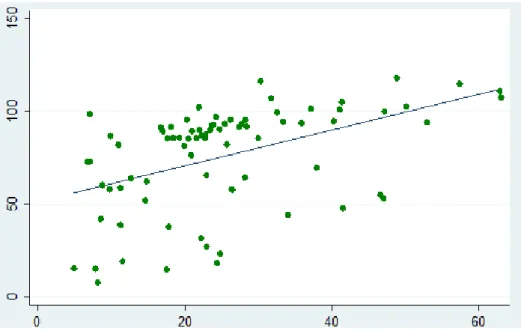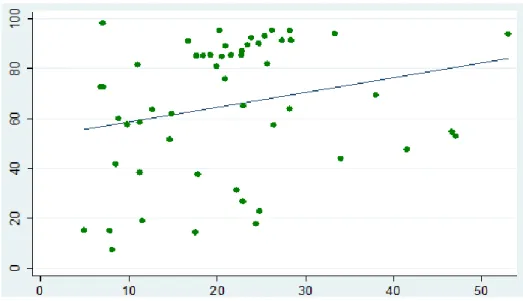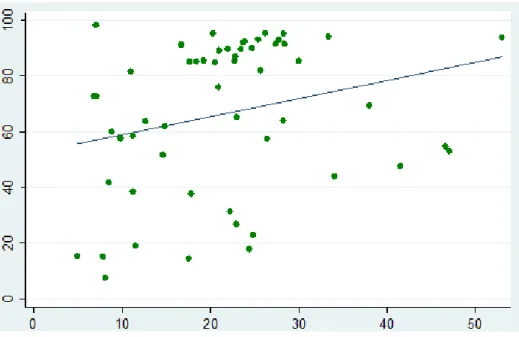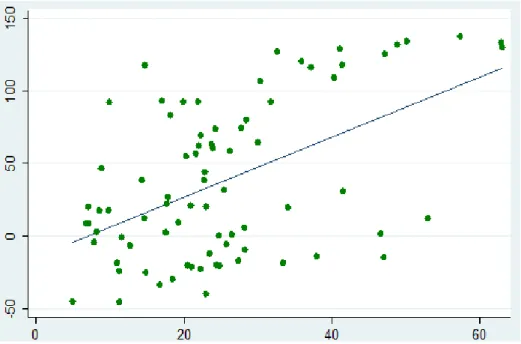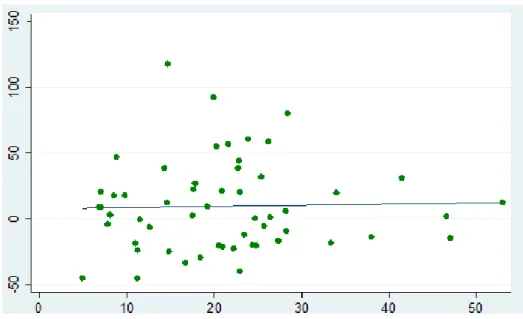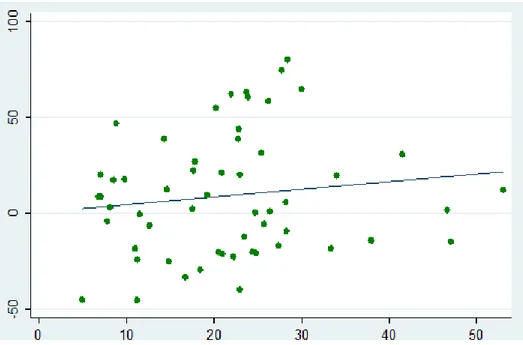UNIWERSYTET EKONOMICZNY W POZNANIU
POZNAN UNIVERSITY OF ECONOMICS
Doctoral Seminars in English
Lobna Bousrih
The Impact of Social Capital and Institutional Quality
on Economic Growth
Faculty of Informatics and Electronic Economy
Department of Mathematical Economics
Supervisor: dr hab. Krzysztof Malaga, prof. nadzw. UEP
Supervisor auxiliary: dr Paweł Kliber
DEDICATION
I dedicate this work to my parents who have guided and taught me throughout my life. Thank you both for being a constant source of inspiration for me. Also, to my husband whose unconditional love; encouragement and support bring me constant joy. To my sisters for always being there holding my hand during hard time.
ACKNOWLEDGEMENT
I would like to express my sincere appreciation and gratitude to Professor Krzysztof Malaga for his constant encouragement, his expert and valuable guidance.
I take this opportunity to record my gratitude to Dr. Paweł Kliber for his helpful discussions and observations.
My great thanks go to Professor Mohammed Salisu, Chief Economist Gulf One Investment Bank for his valuable comments and recommendations.
It is with great honor I would like to express thanks to Professor Emil Panek, Dean of Faculty of Informatics and Electronic Economy and Head of Department of Mathematical Economics for giving me the opportunity to work in a professional environment with highly qualified people.
My appreciation and thanks also go to Professor Maciej Zukowski, Vice-rector of Research and International Relations for his kind permission to me to participate to the Doctoral Seminars in English at Poznan University of Economics.
My sincere thank goes out to all the university members for taking care of all the administrative paper process.
4
Contents
4Summary
6Streszczenie
10Introduction
141.
Social capital, human capital and economic development
241.1. Introduction 24
1.2. Definitions of social capital 25
1.2.1. Individualistic view of social capital 28
1.2.2. Communitarian view of social capital 31
1.3. Relation between human capital and social capital 39 1.4. The place of social capital in the economic literature 40
1.4.1. Social capital and economic development theory 40
1.4.2. Social capital and institutional theory 44
1.5. Concluding remarks 45
2.
Social
capital
and
economic
growth:
empirical
investigations on the transmission channels
47
2.1. Introduction 47
2.2. Empirical debate on social capital 49
2.3. Transmission channels for social capital 51
2.3.1. The physical capital investment transmission channel 51
2.3.2. The human capital transmission channel 57
2.3.3. The institutional quality channel 61
2.3.4. The financial development transmission channel 65
2.4. Seemingly unrelated regressions model 68
2.5. Robustness analysis 80
2.6. Concluding remarks 93
3.
Finance and long-run growth: the role of formal and
informal institutions
95
3.1. Introduction 95
3.2. Theoretical and empirical debate 97
3.3. Empirical investigation 99
3.4. Robustness analysis 110
5
4.
Financial
liberalization,
financial
development
and
banking crisis: the role of social capital
118
4.1. Introduction 118
4.2. Literature overview 120
4.2.1. Banking crisis literatures 120
4.2.2. Financial development, social capital and banking crises 122
4.3. Empirical methodology 123
4.4. Variables and data 124
4.5. Results 127
4.6. Financial liberalization, social capital and banking crises 130 4.7. Financial development, social capital, institutional environment and
economic growth 131 4.8 Concluding remarks 144
Conclusions
145References
149Appendices
160A.
List of countries by categories: 160A.1.
List of countries with different levels of institutional quality environment 160A.2.
List of countries developed and developing countries 161B.
Data source 162C.
Econometric appendix 163C.1.
Seemingly unrelated regressions model 163C.2.
Dynamic panel GMM system model 164C.3.
Logistic regression 1666
Summary
The concepts of social capital and formal institutional quality are getting more importance in the debate on the determinants of economic growth. In order to determine a deeper context of the interrelation between those concepts, in this thesis the author has tried to analyze how interpersonal trust, considered as a valuable asset, can enable people to build important relationships with one with another and help to secure their individual resources and well-being over time. At the same time we have explained how a strong institutional environment can create a proper incentive structure in an exchange process that will enable to uphold confidence between people within the community through equal access to regulation and legislation.
Taking into consideration this importance to the development of formal regulatory institutions as well as the informal ones, like norms, trust and cooperation between people, to economic growth, the present work has explained to what extent the classical literature illuminates the effect of social capital and institutional quality on economic growth and also identified through which mechanism such qualitative factors can generate a high return in the economy.
Two innovations were drawn out in the present work. Firstly, it analyses the different transmission channels through which social capital impacts economic growth and secondly examines the different impacts of such qualitative factors on economic growth for various group of countries classified in terms of their levels of income and also their levels of institutional quality.
Four chapters were developed in this thesis to elucidate the relation between social capital, institutional quality and economic growth:
7
The first chapter identified the key definitions of social capital and scrutinized the relation between the related concept with human capital and economic development, referring to different theories in the economic field.
The second chapter was devoted to analyze, using seemingly unrelated regression method, the different transmission channels through which social capital can influence economic progress in the country in the background of 85 countries and for a subgroup of countries with different levels of income and different levels of institutional environment quality for the period spanning from 1980 to 2009. In this work we consider four transmission channels, which are physical capital investment, financial development, human capital, and institutional quality.
The choice of these transmission channels is based on the fact that: investment, as a transmission channel, is a type of activity that relies more on the future actions of other partners. In fact, high level of trust and cooperation between investors can lead to more honesty within the business environment and reduce the cost of monitoring and enforcing contracts between partners. In the same way, financial transactions in banking and non banking institutions, as another channel, depend not only on the legal enforceability of contract between contractors but also on the people’s moral behavior and trust between them. Similarly, education skills gathered in a formal learning system can generate high positive returns for the economy when knowledge and information are shared between people and felt to be more beneficial to the community and economic activity when we see people use them for a positive purposes in strong social environments. The additional transmission channel is related with the quality of institution. It is commonly accepted that, institutions range from formal regulatory environment to an informal and intangible environment consisting of social cooperation, norms, civism and trust between people, which facilitate better transfer and distribution of resource in an economic process.
8
In the third chapter presented throughout this work the author has employed the dynamic panel system GMM estimators to examine the effect of formal institutional environment quality and social capital on financial development and long-term economic growth. While providing more insights into the concept of social capital and its effect on the development of the financial system, the last and forth chapter was deployed to examine how interpersonal trust can save institutional system from potential economic damage. Using a multi-variable logit model the author has analyzed how well developed institutional environment and high level of social capital can reduce the effect of financial liberalization on the fragility of banking system and the probability of occurrence of banking crisis
Three conclusions can be drawn from this work:
The first is that there is positive and direct association between social capital and economic growth, as well as an indirect positive impact of interpersonal trust on economic activity through its effect on the different transmission channels which are financial development, human capital, institutional quality and investment. This result is also verified for the various categories of group of countries.
The second conclusion stresses the role of formal regulatory institutions and informal institutions, like social capital, norms and interpersonal trust, in the development of financial system and thereby the long-term growth of economic activity. This finding is illustrated for the case of financial liberalization reform and banking crisis.
The third conclusion drawn from this work is that the development of institutional environment as well as social infrastructure with high level of interpersonal trust and cooperation between people within the community play a crucial role in reducing the likelihood of banking crisis occurrence in a country.
9
Keywords: Social capital, human capital, institutional quality, economic growth, economic development.
10
Streszczenie
Koncepcje kapitału społecznego i jakości instytucji formalnych zaczynają nabierać coraz większego znaczenia w toczącej się dyskusji nad determinantami wzrostu gospodarczego. W celu określenia pełniejszego kontekstu wzajemnych powiązań między tymi kategoriami w niniejszej pracy przeprowadzona zostanie analiza, której celem jest próba znalezienia odpowiedzi na pytanie: w jaki sposób międzyludzkie zaufanie, uznawane za pozytywne aktywa, może umożliwić ludziom budowanie ważnych relacji między sobą, a także pomóc w zabezpieczeniu posiadanych przez nich zasobów i dobrobytu w dłuższym okresie.
Jednocześnie celem pracy jest wyjaśnienie w jaki sposób silne otoczenie instytucjonalne może przyczynić się do stworzenia właściwej struktury motywacyjnej w procesach wymiany, która pozwoli podtrzymać zaufanie między członkami społeczności wskutek równego dostępu do regulacji i legislacji.
Biorąc pod uwagę duże znaczenie rozwoju regulacji instytucji formalnych, a także instytucji nieformalnych, takich jak: normy, zaufanie i współpraca między ludźmi, dla wzrostu gospodarczego, w niniejszej pracy doktorskiej pokazano: w jakim stopniu w klasycznej literaturze przedmiotu objaśnia się wpływ kapitału społecznego i jakości instytucjonalnej na wzrost gospodarczy oraz zidentyfikowano mechanizmy, dzięki którym wymienione czynniki jakościowe mogą przynosić gospodarce wysokie korzyści.
Rozprawa doktorska zawiera dwie innowacje w stosunku do istniejącej literatury. Pierwsza z nich sprowadza się do wyróżnienia kanałów transmisyjnych poprzez które kapitał społeczny oddziałuje na wzrost gospodarczy. Natomiast druga z nich polega na analizie zróżnicowanego wpływu czynników jakościowych na wzrost gospodarczy w wyodrębnionych
11
grupach krajów, które różnią się pod względem poziomu dochodów oraz jakości występujących w nich instytucji.
Rozprawa doktorska składa się z czterech rozdziałów, w których wyjaśniane są relacje występujące między kapitałem społecznym, jakością instytucji i wzrostem gospodarczym.
W rozdziale pierwszym podano najważniejsze definicje kapitału społecznego. Określono związki między kapitałem społecznym kapitałem ludzkim i rozwojem gospodarczym w kontekście ważniejszych nurtów współczesnej teorii ekonomii.
W rozdziale drugim przeprowadzono analizę wpływu kapitału społecznego na wzrost gospodarczy w danym kraju, który dokonuje się poprzez różne kanały transmisji. W tym celu zastosowano równoczesne wielorównaniowe modele regresji, które mają autorski charakter. Badania przeprowadzono dla grupy 85 krajów, a następnie wyodrębnionych ich podgrup ze względu na różne poziomy dochodów oraz na zróżnicowany poziom jakości środowisk instytucjonalnych w tych krajach od 1980 do 2009 roku.
Rozpatrzono w nim cztery kanały transmisji wpływu kapitału społecznego na wzrost gospodarczy, za które uznano: inwestycje w kapitał fizyczny, rozwój finansowy, kapitał ludzki i jakość instytucji.
Wybór tych właśnie kanałów przesyłowych opierał się na następującym uzasadnieniu. Inwestycje, w szczególnym przypadku w kapitał fizyczny, są rodzajem działalności, który odnosi się bardziej do przyszłych działań realizowanych przez różnych partnerów. Rzeczywiście, wysoki poziom zaufania i współpracy między inwestorami może prowadzić do większej uczciwości w otoczeniu biznesowym oraz do redukcji kosztów monitorowania i egzekwowania kontraktów wśród partnerów biznesowych. Analogicznie finansowe transakcje w instytucjach bankowych i niebankowych zależą nie tylko od zgodnej z prawem realizacji umów zawartych między kontrahentami, lecz także od ich moralnych postaw i działań, a także wzajemnego zaufania.
12
Podobnie, poziom wiedzy i umiejętności, nabyte w ramach sformalizowanego systemu edukacji mogą wywierać pozytywny wpływ na gospodarkę o ile wiedza i informacje są dzielone między ludźmi i pożytkowane dla dobra społeczeństwa i gospodarki w silnym środowisku społecznym.
W przypadku czwartego kanału przesyłowego, którym jest jakość instytucji, przyjmuje się powszechnie, że instytucje podlegające regulacjom formalnym, instytucje nieformalne oraz środowisko niematerialne, które tworzą współpraca, normy, postawy obywatelskie i zaufanie między ludźmi służą lepszej wymianie, dystrybucji i alokacji zasobów w procesach gospodarowania.
W rozdziale trzecim zbadano wpływ jakości formalnego środowiska instytucjonalnego i kapitału społecznego na rozwój finansowy i długookresowy wzrost gospodarczy. W tym celu zastosowano uogólnioną metodę momentów GMM. Badania przeprowadzono w odniesieniu do analogicznych grup i podgrup 85 krajów i dla tego samego horyzontu czasu co w rozdziale drugim.
W celu zapewnienia pełniejszego wglądu w koncepcję kapitału społecznego i jego wpływu na rozwój systemu finansowego, w rozdziale czwartym wykorzystano trzeci rodzaj modeli ekonometrycznych, którymi są modele logitowe. Posłużyły one do dyskusji nad tym jak chronić zaufanie między ludźmi w ramach istniejącego systemu instytucjonalnego przed potencjalnymi stratami ekonomicznymi. Przy pomocy tego rodzaju modeli ekonometrycznych zbadano w jaki sposób zaufanie międzyludzkie może przyczynić się do zmniejszenia potencjalnych strat gospodarczych. W szczególności przeanalizowano w jaki sposób dobrze rozwinięte otoczenie instytucjonalne i wysoki poziom kapitału społecznego mogą zmniejszyć wpływ finansowej liberalizacji na kruchość systemu bankowego oraz prawdopodobieństwo wystąpienia kryzysu bankowego.
13
Po pierwsze, istnieje pozytywny i bezpośredni związek między kapitałem społecznym i wzrostem gospodarczym, podobnie jak istnieje pozytywny i pośredni wpływ interpersonalnego zaufania na działalność gospodarczą za pośrednictwem różnych kanałów przesyłowych, którymi są rozwój finansowy, kapitał ludzki, jakość instytucji i inwestycje. Wniosek ten jest wynikiem badań empirycznych prowadzonych dla różnych kategorii grup krajów.
Po drugie, instytucje podlegające formalnym regulacjom oraz instytucje nieformalne, do których zalicza się kapitał społeczny, normy i interpersonalne zainteresowanie, grają ważną rolę w rozwoju systemu finansowego oraz długookresowym wzroście gospodarczym. Wniosek ten jest ilustrowany przykładami reform liberalizujących systemy finansowe oraz bankowych kryzysów.
Po trzecie, rozwój środowiska instytucjonalnego oraz infrastruktury społecznej, charakteryzującej się wysokim poziomem zaufania i współpracy między członkami określonej wspólnoty, grają kluczową rolę w zmniejszeniu prawdopodobieństwa wystąpienia kryzysu bankowego w danym kraju.
Słowa kluczowe: Kapitał społeczny, kapitał ludzki, jakość instytucji, wzrost gospodarczy, rozwój gospodarczy.
14
INTRODUCTION
Theoretical foundations of the thesis
Over the past years, a number of theoretical and empirical studies have attempted to identify important factors driving economic growth in major developed and developing economies. In fact, these concepts trace their origin to the first industrial revolution and became popular after the publication of the “The Wealth of Nations” in 1776. Adam Smith highlighted the relation between capital formation and savings as important determinants of economic growth. Later, Thomas Malthus in the “Essay on the Principle of Population” [1798] gave another dimension to the concept. According to him, the growth rate of the population can be a factor to stimulate the economic growth as long as it is accompanied by an effective labor demand. In 1817, David Ricardo in his publication “On the Principles of Political Economy and Taxation” pointed out a new concept and explained that endogenous mechanism like accumulation of physical capital is likely to affect the economic equilibrium in the long run. In his thesis, Ricardo showed that the rate of profit tends to be equal between sectors and converges to zero in the long run. Another distinguishing study developed by Schumpeter [1912] highlighted the importance of entrepreneurship to encourage economic growth. In fact, industrial progress and innovation constitute the fundamental impulse to stimulate capitalist incentive because it creates new production method and new types of industrial organization.
Following the 1929 crisis, many economists, inspired by the work of J.M. Keynes [1936], tried to examine the scope of balanced economic growth as well. One of them, Domar [1946], suggested that investment had a double influence in the economy throughout its effect on income and employment. Neoclassical theory, as it is conceived today, was developed successively by Ramsey [1928], Solow [1956], Swan [1956], Cass [1965] and Koopmans [1965]. In his contemporary economic growth model Ramsey [1928], the pioneer of economic
15
growth theory, argues that it is difficult to study the consumption theory without referring to the condition of optimality. Also, Solow [1956] and Swan [1956] tried to clarify the role of the accumulation of the physical capital, the rate of saving and exogenous technical progress in the economic growth. Cass [1965] and Koopmans [1965], using optimization analysis, suggested that long-term economic growth is linked to the exogenous technological progress growth rate. In fact, the argument introduced by Cass and Koopmans is that all economies which have access to the same technologies must converge towards the same income per capita.
It is worth saying that debate on the determinants of economic growth has been controversial for a long time. Some economists have argued that economic growth is determined by exogenous factors while others have argued that it is more linked to some endogenous determinants. Researches on the economic growth model during the middle of the 1980s made a new great stride. Romer [1986], Lucas [1988], Barro [1991] and Grossman and Helpman [1991] tried to explain that economic growth rate was highly linked to some endogenous factors. According to them, the technological progress, which was considered previously by Cass [1965] and Koopmans [1965] as exogenous, is more or less determined by the human capital, the productive public expenditure, the research and development, trade openness and institutional environment. These factors together act positively on economic activities, measured by the gross domestic product (GDP), and wealth created in a country. However, despite all these efforts to select the determinant of economic growth and its measure, it appears that economic growth in a country may not reflect the well-being of people because it does not take into account other qualitative aspects like social costs, and it also does not record the underground economy. All these may decrease the value of economic growth and later the well-being of people within the community. In fact, various literatures pointed out the importance of economic development concept as a complement to the traditional economic literature that explains growth through efficient allocation of resources and evaluate economic
16
growth by the annual increase of GDP. Authors like Todaro and Smith [2009] argue that the economic development concept deals with greater scope of issues such as social, institutional mechanisms and large-scale factors that improves the level of living of the people.
The economic development concept, however, is a qualitative phenomenon, irreversible and can only be observed over a very long period. We can define a development process by the combination of changes in the overall economic, social, cultural and demographic structures1. Many criteria evolve simultaneously in the production process and in the labor force, like life expectancy, the infant mortality rate, literacy rate, the number of students, researchers, etc. These indicators are therefore, the qualitative aspects that are not addressed by the measure of economic growth. Clearly there is a link between these two concepts as growth provides resources to finance development, while at the same time development is accompanied by improvement of living favorable to growth.
Indeed, the task of identifying how to achieve economic development remains one of the major concerns of economic theory. Some studies highlighted the issue of income difference among countries, and why some have achieved double digit economic growth (particularly East Asian countries), while others remain at a lower range (particularly Sub-Saharan African countries). To clarify this, Chenery [1975] pointed out some of the deficiencies of the neoclassical approach for developing countries. According to him, the existent literature does not take into account factors like market imperfection, external constraints, domestic demand constraints and a number of other factors raised by development economists.
1
Any changes in the standard of living will generate a positive impact on the quality of life of people in the community.
17
Motivation
Actually, rethinking the issue of economic development leads economists to incorporate other qualitative factors in economic growth models. Many regard the concept of social capital as a key ingredient of economic development.
The purpose of the present work is to explain to what extent does the economic literature, mentioned earlier, illuminates the effect of social capital on economic growth and to find out how the social capital literature can be moved forward, particularly in terms of its transmission channel. The main idea behind this work is to show that economic growth can make more and more resources available for the well-being of the individual, in particular, and the community in general; at the same time good social conditions improve the quality of institutional environment, which may impact on the economic activity and long run economic growth.
Actually, the conception of individual well-being depends on many factors like social environment, individual social status and aptitude to build important and satisfactory relationships with other persons. In other words, individual well-being becomes not only a matter of achieving better work and life balance but also a matter of building-up a satisfactory individual and social identity that can help to secure over time individual businesses as well as community cohesion. However, these two processes in some cases may not be feasible because indecent people may engage in corrupt activities and end up getting things done illegally and thereby generate considerable economic damage to society.
What are the transmission channels through which social factors like individual networks, trust, and civic society can impact on economic performance? And, what measures can be taken to satisfy and secure individual well-being in the society is the question?
18
To answer to these questions we will try in this work to explain, first, what we mean by social capital. And, second, explain through which mechanism such as social capital can generate a high return in the economy.
Understanding the importance of building relation with people with good faith within a group or a community will allow us to highlight the mechanisms through which social capital can impact positively economic growth in the long term. Moreover, a better social environment, with good information sharing, knowledge, and respects of rule and law, is a perfect ground for the dissemination of good norms and trust. In this respect, improving social confidence between people within the society is a matter of knowing how to maintain a good institutional environment that respects legal rule of law and operate for the welfare of all people, and also how to build good cultural and social education between people to sustain economic well-being over time.
In light of the literature on social capital, there are two innovations in our work. First, to our knowledge, there are no studies which have unearthed the transmission channels by which social capital impacts economic growth2. The second novelty of this work is the deliberate focus to analyze the impact of such a qualitative factors on economic growth for different groups of countries with the different levels of income and also with the different levels of institutional quality3.
Organization of the thesis
To analyze the importance of social capital and the mechanisms through which it can impact positively economic growth, we will try to develop the key issues into four chapters.
2
As a continuation of my earlier paper published in 2008, the present work analyzed the transmission channels by which interpersonal trust as proxy of social capital impacts economic growth for a larger sample of countries than previously used.
3
In future research paper we are planning to test the same idea of the impact of social capital and its transmission channels on economic growth for other different types of classification of group of countries for example with different political system, religions, cultures ect….
19
In the first chapter, we will highlight two main ideas: first, whether there is a relationship between social capital and other determinants of economic growth like human capital. Second, we focus on the importance of social capital through the process of economic and institutional development. To do this, the first chapter will include five main sections. In the first section, we will set out the main definitions of social capital as explored in the literature. The second section will present the relationship between social capital and human capital. The third will analyze how social network can influence the process of economic development. The fourth section will present the relationship between social capital and institutional development. Finally, section five will pull together the main conclusion of the chapter.
In the second chapter, we will discuss the hypothesis that social capital has a direct and indirect impact on economic growth with particular emphasis on the different transmission channels of social capital to economic activity. Since individual relationships do not enter in the gross domestic product (GDP), in this section we will analyze how social capital accumulation can contribute to economic growth: first, for a sample of 85 countries, and second for different groups of countries with different levels of income and different levels of institutional quality over the period spanning from 1980–2009.
Four main transmission channels are highlighted in the second chapter; these are human capital, financial development, physical capital investment, and institutional quality. The choice of these channels is not random. In fact, the knowledge and skills gathered in the formal learning system can be sustained to positively impact economic growth when there are strong social environment platform and active social network and trust between individual, where people share freely information and knowledge between them. Indeed, the quality of interaction between people matters in the sense that individuals may misuse the knowledge
20
they have and accomplish less in the environment with less trust and cooperation between people.
Similarly, transactions in the financial system are nothing more than daily basic exchange of money on a promise to return it in the future. Such an exchange will therefore depend not only on the legal enforceability of contract between the financer and the financee but also on the people’s moral attitude and trust between each of the contactors. It is then evident that the use of financial contracts within the community will depend upon the level of trust between the groups.
Physical capital investment is also considered as another transmission channel of social capital to economic growth. In fact, higher trust and cooperative behavior between economic agents lead to more honesty within the business environment and reduce the cost of monitoring and enforcing contracts between partners. In the presence of high trust and civic norms between partners, the available resources in terms of money and time will be used for real productive activities. Investment is a type of activity that relies more on the future actions of other partners, which can be done at lower costs if there is high confidence environment.
The fourth transmission channel of social capital quoted in the literature is institutional quality. It is clear that an institution’s system of governance defines the structure of human incentive in an exchange process. In fact, weak institutions will increase the level of uncertainty and untruthfulness in the organization, and reduce the efficiency of investment that will impact negatively on economic growth. However, institutions range from formal regulative environment to an informal and intangible environment that consists of social cooperation, norms, civic and trust between people, which facilitate better transfer and distribution of resources in an economic process. In fact, institution provides the structure of interaction and builds up the relationship, at the same time it enables to uphold confidence between people within the community through equal access to regulatory and legislation.
21
Given that social capital interacts with each of the transmission channels and economic growth, in the second chapter we will try to examine this connection between economic growth and investment, financial development, human capital, institutional quality as well as social capital, using the simultaneous equations model as an effective tool to analyze the interconnected multivariable system of equation. In our model, we will utilize the trust index as a measure of social capital and as an important component of any social cohesion as well as indicator of people honesty and cooperation based on commonly shared norms. The set of transmission channels includes the investment indicators, measured by the ratio of gross capital formation with respect to GDP; the human capital indicator, measured by the average school enrollment secondary (% gross)4; the financial development indicator, measured by the average ratio of liquid liabilities (or money supply) to GDP; and finally, the institutional quality environment, measured by institutional quality index introduced and calculated by Kaufmann et al. [2010]
The main finding in this chapter is that there is a positive and significant association between social capital and economic growth. This effect of social capital on economic growth can be viewed through different transmission channels which are financial system, human capital and institution. This result is also confirmed for the set of developed and developing countries taken separately, as well as for the group of countries with high control of corruption and medium and low control of corruption. Such outcome can help us to understand more the mechanism through which social capital operates.
In the third chapter we will discuss the hypothesis that formal institutional environment quality, as one of the transmission channels, and social capital can influence financial system development and long-term economic growth. In fact, institution is made up of both formal and informal rules. The formal rules have mainly the character of being
4
22
straightforward and defined by laws and regulations. However, informal rules are more intangible and categorize all norms and people’s behaviour within the society that can deliver informal constraints and do not show up in formal institutional system and can impact on economic activity’s fluidity and transparency.
The output of the estimated dynamic panel system GMM model5 shows the importance of social capital values in financial development and long-term economic growth. At the same time improvement in the quality of formal institution such legal rule of law plays an important role in the progress of financial institution that will impact positively on economic performance and growth.
While providing more insights to the concept of social capital and its effect on the development of institutional quality, chapter four will be dedicated to study how loyal and interpersonal trustful society can save institutional systems from potential economic damage. In this chapter, we will analyze this relationship for a particular phenomenon, namely banking crisis. First, we will test the hypothesis that banking crisis may come along with financial liberalization and second see especially if the probability of banking crises depends on factors other than those related to market conditions: i.e. the quality of the environment institution or the degree of trust between different actors within the economy.
The different estimates carried out in this chapter emphasis on the importance of the development of institutional as well as social environment, trust and cooperation between people in reducing the probability of occurrence of banking crisis. Effective trustful network and civic activities can also help to improve financial activities in the banking system that can generate later positive impact on economic growth.
Light at the end of the thesis, all drawn conclusions in each chapter on the importance of social capital and institutional quality to economic growth will be specifically developed
5
The dynamic panel system GMM model offer a convenient framework for obtaining efficient estimator and solve the problem of endogeneity that may arise between the estimators.
23
with an eye view toward strong, stable, sustainable and healthy community. Numbers of future research direction will be also suggested to give more insight to the concept of social capital and its importance to community well being.
24
Chapter I
Social capital, human capital, economic growth and
development
1.1. Introduction
During the 1990’s a number of researchers have focused on analyzing the concept of social capital and its importance to economic development. The first contributions to this debate go back at least to that of Hanifan [1916] who tried to show the importance of community participation in improving the quality of education. Later, Banfield [1958] demonstrated that the economic backwardness of southern Italy was due to the low level of social capital within the nation. Since then, many sociologists like Homans [1961], Jacobs [1961] and Loury [1977] used the notion of social capital to explain the importance of community links to the development throughout the nation. Similarly, researchers in the economic fields such as Durlauf [2002], Helliwell [1996], Knack and Keefer [1997] and health [Lynch et al., 1997] also contributed to the debate. However, despite all efforts to enlighten the notion of social capital, many economists still did not show significant interest in it; until the contributions of Bourdieu [1980, 1986], Coleman [1988] and Putnam et al. [1993] that polarized the concept of social capital and its use became fully compatible with the relational understanding of economic actors’ activities.
It is largely accepted that the historical literature on economic growth focuses mainly on physical capital, human capital and technological progress as key determinants of economic growth; however, it neglects other qualitative factors that may impact positively on economic growth and lead to economic development of a country. In the first half of the
25
chapter we will try to point out the most relevant definitions of this qualitative factor and shed the light on relatively few aspects of the complex interplay between social capital, human capital, economic growth and economic development. The main theme is to show that there is a link between these concepts. On the one side, economic development generates more resources available and better condition for the well-being of the nation; and on the other side, good social environment enriches institutional quality, which has an impact on the economic activity and the long-run economic growth. In the second half of the chapter, we will analyze the related concept of social capital with reference to different theories in the economic field like developmental and institutional theories.
1.2. Definitions of social capital
The past decades have seen many investigations of the concept of social capital and its eventual connection to economic performance. However, definition of the notion remained elusive due to the lack of appropriate data and uniform measurement method widely accepted by the literature. The first recorded instance of the term social capital can be traced back at least to Hanifan [1916] who underlined the importance of community participation in promoting quality of schooling. Later, Banfield [1958] used the social capital concept to account for the economic backwardness of the south of Italy, but did not express significant interest in the development economics debate. The term “social capital” also continued to be present in social science debates and in the contribution of Homans [1961], Jacobs [1961], and Loury [1977] that used the term to underline the benefit of community ties. Nevertheless, the lack of conceptual clarity led to overuse of the notion of social capital in such a way “trying to explain too much with too little and be adopted indiscriminately and applied imprecisely” [Lynch et al. 2000].
26
The popularization of the concept in recent decades can be owed to Bourdieu [1980, 1986], in whose works social capital is conceived as a resource that arises from membership in associations, communities, and social networks. According to him, “The volume of social capital possessed by a given agent depends on the size of the network of connections that he can effectively mobilize”.
Coleman [1988, 1990] added a new dimension to the concept and considered that social capital can be defined by its functions, where it is recognized as a group of entities acting to facilitate individual actions in different organized structures. As argued by Coleman, social capital can have three forms; firstly, obligations and expectations which depend on the trustworthiness of the social environment; secondly, the capacity of information to flow through the social structure in order to provide a basis for action and thirdly, the presence of norms accompanied by effective sanctions.
In the early 1990s, this sociological concept experienced resurrection since it was adopted by political scientists like Putnam et al. [1993] and Fukuyama [1995]. Putnam et al. [1993] classifies social capital as “features of social life such as networks, norms, and trust that enable participants to act together more effectively to pursue shared objectives”. In this context and according to this view, social capital became a virtue of nations where individuals obey laws, choose their leaders in a democratic way and show high levels of cooperation between themselves. It is also considered as positive group externality that arises from social organization, an argument largely debated by Fukuyama [1995] who suggests that only certain shared norms and values may be regarded as social capital. According to him “Social capital can be defined simply as the existence of a certain set of informal rules or norms shared among members of a group that permits cooperation among them. The norms that produce social capital must substantively include meeting of obligations, and reciprocity”. Similarly, the OECD [2001] pictures the notion of social capital as “networks together with
27
shared norms, values and understandings that facilitate co-operation within or among groups”. In addition, the World Bank [2011] suggests that “Social capital refers to the institutions, relationships, and norms that shape the quality and quantity of a society's social interactions. Social capital is not just the sum of the institutions which underpin a society – it is the glue that holds them together”.
In sum, there are two main approaches to explain the concept of social capital: one considers social capital as an individual attribute6 and another argues that social capital or the social network can be more an attribute of the community itself7.
In the field of economics, it has become more and more accepted that social capital improves not only the capabilities of the different agents at an individual level, but also the general economic performance at the aggregate one. Becker’s [1974, 1996] social capital is conceived as an intermediate good to produce the basic needs of individuals. Moreover, a clean social environment where people meet freely and frequently is an ideal ground for the adoption and diffusion of good norms and trust. Therefore, a generalized trust for the society can reduce uncertainty and the average transaction costs just like other inputs [Torsvik 2000; Zak and Knack 2001].
At an aggregate level, generalized trust-based relations may have a positive impact of the process of development and economic growth in particular. It may be a factor that accounts for the gap of growth performances between regions even in developed countries and the underdevelopment of urban and rural areas in the poor countries [Temple and Johnson 1998, 2001; Guizo et al. 2000]. Ostrom [2000] and Rose [2000] argue that high level of social capital generate an added value to economic growth by facilitating alliance between people interests that will have a positive impact in the production process. Mogues and Carter [2005], Rupasingha et al. [2006] add that countries with relatively high stock of social capital, in
6
Individualistic view was documented mainly by Coleman [1988, 1990] and Bourdieu [1980, 1986]. 7
28
terms of generalized trust and widespread civic engagement seem to achieve higher levels of economic growth, compared to those with the low levels of trust and civic.
Actually, both views of social capital with an individual-level definition and community level one are present in the literature. In the following section we will discuss the core intuition guiding the social capital research.
1.2.1. Individualistic view of social capital:
An expanding economic literature perceives social capital as an individual resource held by a person [Paldam and Svendsen, 2004] as well as an instrument to edge down transaction costs in the investment process [Szreter, 2000]. This individualistic vision appears also in the study by Glaeser, Sacerdote and Laibson [2000]. According to them, individual social capital is “a person’s social characteristics including social skills, charisma and the size of his Rolodex which enables him to reap market and non-market returns from interactions with others”. Using an optimal individual investment decision8 model Glaeser et al. considers that every individual acquires per-period utility flow of where, represents the individual social capital as a stock variable. refers to the aggregate per capita social capital stock and is the differentiable function of aggregate per-capita social capital.
In fact, can reflect both market and non-market returns. The market returns may take into account the level of individuals’ salary and position within the society. The non-market returns can be composed of community well-being progress, as well as improvements in living standards and happiness in the society. It is assumed that social capital generates positive externalities : .
8
The difference between individual decision analysis and the group decision analysis is that this former emphasis only on the decisions of individual actors in contrast with the decision to the group stresses more on institution and aggregate group outcome.
29
The equation of the depreciation factor arising from mobility, which can decrease social capital if there is no investment to renew, can be represented as follows:
, (1.1) where: is the probability to reside with the same community and is the discount factor if the individual changes the location where he lives.
The individual maximizes his objective function, taking into account the aggregate social capital per capita, as fixed.
The individual’s maximization problem can be stated as follows:
, (1.2) subject to:
,
where: - the investment made at the moment ; - the time cost of investment (where the function is increasing and convex); - the opportunity cost of leisure time, refers to the stock of social capital that has been accumulated over time until the moment , - the depreciation factor occurring from mobility and - means the depreciation rate which reflects “the effects of changes in the mortality rates of the other members of one’s social network and changes in one’s own physical and mental ability”. According to Glaeser et al. [2000] an increase in the depreciation rate would adjust the predicted decrease in social capital investment in the future. - individuals’ lifespan and - the discount rate.
The individuals can move from one place to another but such change has the impact to decrease their amount of social capital.
The first-order condition is as follows:
30
The static results show that social capital investment increases with the discount rate and with the returns to social skills gained from a high amount of the social capital in the community . Furthermore, it rises in community with more aggregate social capital and when social capital is fewer community specific, measured by the parameter .
However, social capital investment declines with the mobility , with the opportunity cost of time , with the rate of depreciation and age .
The level of social capital accumulation depreciates toward the end of life, and the benefit of investment goes to zero. Therefore, Glaeser et al. [2000] in their model suggest that individual social capital will peak during the person’s midlife9
.
Given this, we can distinguish two main properties of social capital. One regards social capital as an asset with higher community specification and the other one considers it as capital with strong interpersonal complementarities10. These complementarities may put forward large social multipliers and its effect on the change in a parameter may be higher compared with the effect on the change in the same parameter for an individual.
Putting these points into formula, Glaeser et al. [2000] assumed infinite time-horizon and examine the steady-state levels of social capital. According to them, in the steady state and considering changes in individual wages we obtain11
:
. (1.4)
In case of an aggregate change in wages, with the assumption that the community is homogenous where , we have:
, (1.5)
9 This result supposes that the function does not vary over the life cycle. 10
This finding can be also true for both physical and human capital. 11
31 where:
is the social capital multiplier. Equations (1.4) and (1.5) show that an aggregate
change in wages has a bigger impact on social capital compared with an individual change in wages.
Therefore, being a part of any social network, such as an association, can help an individual to build his social capital that will generate later tangible and intangible returns such as information flows, trust, loyalty, altruism, and cooperation, which will serve both the investor and the other members to the network.
1.2.2. Communitarian view of social capital
In the literature the concept of social capital has been used to show how such resources can jointly with other factors such as, financial, physical and human capital, produce a different levels of outcome. Beugelsdijk and Smulder [2009], in their study regarding the importance of social capital on economic growth have tried to show the effect of the two types of social interaction on economic growth. These authors could demonstrate that the degree of social interaction between expanding numbers of individuals have a positive effect on economic growth while close interactions can only hinder economic growth. To analyze these results Beugelsdijk and Smulder [2009] consider the following utility function form:
, (1.6) where: refers to the consumption of goods and represents social interaction. are the marginal utilities of and , respectively. In their paper, social interaction is defined as the level of individual participation in social networks, and it can have two forms:
32
open network that brings together different community noted ; "Bridging".
The utility function of individual social interaction can be as follows:
, (1.7) where:
represents the intensity of participation in and refers to the intensity of participation in measured by the time devoted to it. are the marginal utilities of and , respectively.
The specification of the standard constant elasticity of substitution (CES) function is as follows: , (1.8) and: , (1.9)
where: refers to the materialism preference parameter12, represents to the family ties preference parameter, which measures the importance of relative to and and characterize the elasticity of substitution between the two types of social networks and between consumption and social interaction, respectively.
Individuals’ choice between present consumption and social interaction is constrained by the time (or budget). Consumption is constrained by income, which is derived from working at a wage and from rent seeking transfers, according to the following budget constraint:
12
33
, (1.10) where: the total time available for working and social interaction, the time devoted to social interaction in , the time devoted to social interaction in . represents the individual’s wage and, refers to the transfer (which may be negative).
Individual social capital requires social interaction and time, which comes at the cost of working time. Hence the trade-off between social interaction and material consumption may have negative effect on economy in the process of creation of social capital. Despite the negative side of social capital to the economy, Beugelsdijk and Smulder [2009] assume that social interaction may have positive impact on economic activity through its effect on the degree of people opportunism. The idea is that agents engage in (time-consuming) rent seeking activities, by which we mean corruption and extorting, shirking and distrusting. By doing so, they can effectively extract part of the income of others. However, participation in open networks protects agents against rent-seeking: we assume that people that are in the same open network never rob each other.
To gain value added benefit from social network and interactions people tried to built-up reputation and honesty across members of the grobuilt-up in order to protect themselves from any act of robbery or rent-seeking. Beugelsdijk and Smulder [2009] identify two sets of income extraction: the direct one can be linked to theft or robbery and the indirect one can be associated with cheating. In the model the authors assume rent-seeking is directed at persons outside his own community . But, you may risk that some of your rent-seeking actions affect members from your group , something you can avoid only after you have already spent the time preparing the rent-seeking activities . In such a situation the
34
expected average benefit of rent-seeking can be , where refers to the average wage and refers to the time devoted to preparing rent-seeking activities13
.
In total, the actual benefit will be because only persons outside the will be eventually robbed. In this case, Beugelsdijk and Smulder [2009] assume that the higher the wage and the rent seeking; the smaller is the number of fellows in the , who will desist from robbing.
At the same time these gross negative fund transfers can be articulated as , where refers to the damage from being robbed per unit of wage income,
and is the average level of rent-seeking activity within the society. Therefore, the net transfer from this robbing act can be as follows:
, (1.11) where: refers to the time devoted to rent-seeking, and the opportunity cost of time devoted to work and social interaction. Normalizing the total time endowment to unity, the following time constraint applies: , where is the time spent for work and social interaction.
The consumer-choice optimization problem can be summarized as follows:
max , (1.12) subject to:
(1.13) , (1.14)
where: , and are respectively: therent-seeking levels in society, the individual wage and the average wage. The first-order maximization conditions can be represented as follows:
. (1.15)
13
35
In this equation (1.15) the marginal benefits of rent-seeking (left-hand side) is equal to the marginal opportunity cost14 (right-hand side).
. (1.16)
Equation (1.16) evaluates the optimal trade-off between the two types of network interactions. The left-hand side of the equation represents the amount of time devoted to that individual is willing to give up in exchange for an additional unit of time devoted to participation (marginal rate of substitution). The right-hand side gives the opportunity cost of engaging in participation rather than in participation (marginal rate of transformation).
Spending time with friends has a relatively low cost compared to spend time in extra community networks, if the net loss from rent-seeking is high.
. (1.17) The equation (1.17) determines the optimal trade-off between the material consumption and social interaction in .
Static equilibrium under symmetry
In their model Beugelsdijk and Smulder [2009] suppose that all agents have the same revenue and preference and will make the same decision choices.
Hence we have:
and . (1.18) They assume that if all agents engage in the same intensity of rent-seeking, the losses are a constant factor larger than the benefits:
, (1.19)
14
36
Therefore, rent-seeking act will be a negative sum game: what the extorter gains is less than the damage to the person being extorted. At the same time, the portion of the money may be lost “in the battle” or seized by authorities. One could also consider this as an implicit way of modeling the costs that the victim has to bear to circumvent cheating and shirking called as well monitoring costs. Parameter captures this externality cost of rent-seeking15.
To summarize, we distinguish exogenous and endogenous driving forces in the model: the first group includes labor wage , preference for material consumption (materialism ) and preference for family and friends’ ties . And, the second set refers to variables like and . In the equation (1.15) and (1.18) shows that there is a negative relationship between and :
. (1.20) Then, substituting this result and (1.20) and (1.19) into (1.16) will show that is a positive function of and :
(1.21) where are the marginal utilities of and , respectively.
Substituting these results into the budget constraint, the following budget constraint can be written as:
(1.22) where
The above equation shows that networks can impact economic activity through five channels16. The first illustrates that more social interaction in reduces directly labor time and hence reduce output. Second, different types of social networking are positively correlated, so an increase in also increases time spent with friends and family and further reduces working time. Beugelsdijk and Smulder [2009] call these effects the labour time crowding out effect. The three other effects come from the fact that
15 It is realistic to add this negative externality. However, all our qualitative results go through when . 16
37
protects against rent-seeking. In extended social networks, there are less acts of rent-seeking and robbery; more time will be devoted to production process, and smaller is the total negative externality. Therefore, the negative and positive effects of on economic activity will depend on whether the negative labor time crowding out effect dominates or not the positive protection against a rent-seeking effect.
In the equation (1.22) Beugelsdijk and Smulder [2009] show that materialism has no direct impact on the economy; however, it can have an indirect impact of economic activity only through its effect on . Indeed, after substituting the solutions for and into equation (1.17), equation in and , including can be written as follows:
where . (1.23) The above equation shows that there is a positive relationship between consumption and . This result is not a surprise as social interaction and material consumption goods are considered as normal goods and spending on these two can be higher of the category of rich people. Also, more materialistic preferences (higher ) or higher-income results in higher consumption for given .
According to Beugelsdijk and Smulder [2009], the sign of is ambiguous because on one hand, high penchant to family ties can have the impact to keep away individual preferences to material consumption, and on another hand a given level of interaction with family and friends can lead to more utility from social interaction.
Another result found by Beugelsdijk and Smulder [2009] is that stronger preference for closer network and family attaches (higher ) can have two reverse effects: it has a substitution effect because it swings people’s attention away from material consumption, and income effect because interaction with family and friends generates more utility from social interaction and increase material consumption .
38
The graphical representation of equations (1.22) and (1.23) can be seen in a simple diagram as follows:
Figure 1.1. Semi-reduced form of equations 1.22 and 1.23 (The dotted line reflects the increase in materialism)
Two main results can be deduced from these graphs:
there is negative relationship between material consumption and bridging social capital when the labor time crowding out effect dominates and the slope of is negative,
in the lower panel, slopes rise, both consumption and social capital fall
In fact, the negative and positive effect of materialism (as measured by a change in ) on the economy will only depend on the relative strength of the crowding-out effect and
a. Labour time crowding out dominates
b- Protection against rent seeking dominates
39
protection against- rent-seeking effect. Also, any rise of the family ties preference parameter can decrease bridging social capital, and is likely to hurt economic activity.
1.3. Relationship between human capital and social capital
Human capital is considered as an important factor to achieve economic growth. However, the definition and the measurement of the concept remained very broad. It is only after the publication of Becker [1974] that human capital notion tends to narrow, and its measure became appropriate for the use of the economic growth model. Ljungberg [2002] tried to explain the causal relationship between education and economic growth in Sweden for the period from 1867 and 1995. The same idea has been investigated also by Nunes [2003] for the case of Portugal between 1852 and 1995.
There is a general view that education and social capital are positively correlated and vice versa [Putnam, 1995; Helliwell and Putnam, 1999; Alesina and La Ferrara, 2000; Glaeser et al., 2000; Rupasingha et al., 2006]. In his seminal contribution, Knack and Keefer [1997] highlighted that the better people are educated, the better they are informed, the more open to the outside world and the better they analyze the information they collect. It also enables people to engage in society with better institutional environment that favors civic, better transfer of the information, transparency. It is considered like a platform for interaction between people, help to ameliorate the quality of life and strengthen individual relationships. It is a powerful tool of exchange of information and knowledge. “It’s not what you know, it’s who you know” (Woolcock, [1998]). In the same field, Nahapiet and Ghoshal [1998] suggest that the component of human capital consists of: human skills and knowledge, abilities of people, social relationship between people and knowing capability of a social collectivity, such as an organization. The development of human capital, therefore requires attention to these other elements like social and organizational issues. This idea has been developed later
40
by Gratton and Ghoshal [2003]. For them, intellectual capital and human capital also includes within it social capital and emotional capital.
Like others, Ian Falk [2000] tried to give much clearer picture on the relationship between social capital and human capital. According to him, the stock of human capital gathers both formal and informal learning, the skills and knowledge that people built through meaningful interactions between each other. In this case, social capital promotes active and sustainable learning environment. Such learning environment can develop interpersonal trust, knowledge and self-confidence between people within the society that provides a strong platform for more action and encourages decision-making working for the wellbeing of the nation.
1.4. The place of social capital in the economic literature
It is now widely accepted that social capital is becoming increasingly important in today’s workplace. It is considered as a tool with which to improve economic and organizational performance, as well as a help to build effective political and social institutions that in turn encourage confidence and civic between individuals in the society. In the following section, we will analyze the different conceptualizations of social capital concept within the economic theory literature.
1.4.1. Social capital and economic development theory
Over time, the economic literature has given us a wide range of varying and contesting definitions of the notion of development. In broad terms, this historical notion tried to explain how to evaluate the position of different countries relative to their level of income and to analyses the forces that are contribute to promoting a country’s future progress. In fact, many authors, like Amartya Sen [1999], argue that it is not only economic growth that determines a
